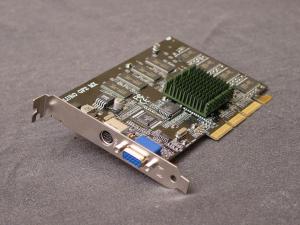|
ABIT Siluro T400
The Card
Before proceeding any further, let's get a few things straight about the GeForce2 MX 400. It does not feature any major changes over the original MX. Memory bandwidth, the
main hindrance to performance on the MX, is unchanged. Like its predecessor, the MX 400 can come with either a 128-bit SDR or 64-bit DDR memory bus, giving it a bandwidth of 2.7GB/s. Its number of rendering pipelines also remains unchanged at two.
Fill rate may not have been improved by any addition of pipelines to the MX 400, but it has been improved by the sole change Nvidia did make: increasing the core clock speed. That 14% increase from 175 to 200MHz ups the theoretical fill rate from 350 million pixels and 700 million texels per second to 400 and
800 respectively. Given that most MX cards were overclockable to 200MHz with no extra cooling (active or passive) anyway, many peoples'
suspicions that this is prettz much the same chip seem reasonable.
Turning our attention to the card at hand: The Siluro T400 comes on an all-black PCB with forest green passive heatsink. Some may bemoan this choice over
active cooling, but since the original MX's reference design called for no heatsink whatsoever, passive cooling may be all that is really needed. I like the fact that ABIT has made the card tall and narrow rather than short and wide to avoid any possible interference with memory slot
clips.

The T400 has 8 Hyundai SDRAM chips for a total of 64MB. This makes more sense than the 32MB design that is also possible and that was commonly seen with original MX cards. There are no fancy extras such as LEDs or hardware monitoring; this is also quite logical, as most potential customers of this card probably don't want to pay for such features.
As you can see from the picture, the T400 does have one extra feature: a TV-out
port. This is what the "T" in T400 stands for: there is also a non-TV-out version of this card available, called the Siluro MX400.

Siluro boxes keep improving with each release; they've come a long way since the first one that had a picture of a monster's hand rolling rolling human eyeballs across an outer-space landscape. The CD includes the manual, drivers, some freeware: WinDVD as well as a couple of ABIT-made tools, such as TrayIcon, which lets you change resolution on the fly and GraphicMax, which allows you to tweak the core and memory clocks from Windows.
Copyright
All-About-PC. All rights reserved.
All information on this Website is protected by All- About-PC.
Reproduction and/or sale in any form without agreement of the
publisher is forbidden. All information on this website has been
thoroughly researched and as far as is possible has been verified by
secondary sources, but we can not take responsibility for the
content or for any damages incurred by using this information. |
|


